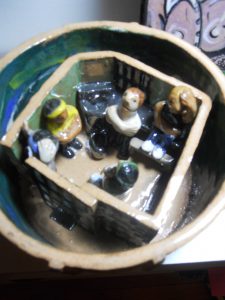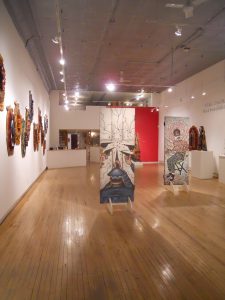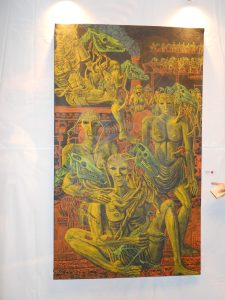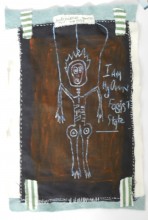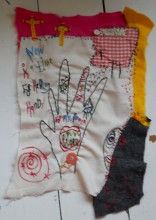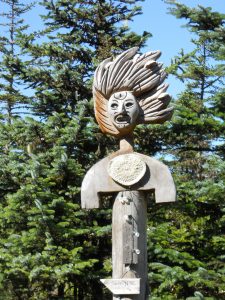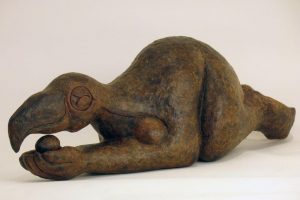 The following is an interview with UK fabric artist, Anthony Stevens. See previous blog for more images of his work.
The following is an interview with UK fabric artist, Anthony Stevens. See previous blog for more images of his work.
Q: Tell me about yourself.
A: I’m a 35 year old U.K resident who lives and works in beautiful, bohemian, Brighton, with my partner and two cats. I enjoy creating art, good food and chanting NAM MYOHO RENGE KYO (I always chant about my work and most of my ideas come this way). I also like to read and write short stories and poetry. I originally hail from Birmingham, a large industrial city in the middle of the UK. I had some very tough and traumatizing experiences growing up there; however, I have still led a varied and full life, but one that has for the majority been accompanied by periods of mental distress of varying degrees and intensities. I’m a firm believer in turning shit into compost and growing a garden. I guess that it is this philosophy that has best informed my work, both in art and my work as a ‘Peer Support Specialist’. (I work part-time for an organization that is entirely staffed by people with lived experience of mental distress and recovery.) I believe that the individual when given the time, space and appropriate support will always know what is the best way forward for them and make their life grow into something personally meaningful and beautiful to them.
Q: When and why did you start to create art. Did you start with fabric, or some other medium?
A: I have always been creative in some way since early childhood, whether that was making little cloth bags, writing stories with illustrations or making sculptures from my sister’s dolls. I have also used art in my other work, which has mainly been in the realm of working with adult mental health and learning disabilities. However, my creativity really started to blossom in 2007, when I started practising Buddhism. I was living at a magnificent place just outside of Edinburgh, called Newbattle Abbey (a high support college for adults returning to education). I think this was the first time in my life I had ever given myself the opportunity to have some time for myself and really see what makes me tick. The combination of environment, time out and support really got my inner cogs turning again. Ironically, the course I did had nothing to do with art and was more geared towards social sciences and literature. However, I spent a lot of time creating an art installation for our end-of-year celebration, using old cardboard boxes, paint and photocopied pictures of all us students.
As for working with fabrics, this came about in 2010. I originally wanted to create my own t-shirt designs as I found so many of the clothes I saw boring. I ended up buying a huge sack of cloth scraps from a dress shop in Brighton and got to work. However, I started to see a synergy with the process I was using, my life, and the way I perceive life to work. I would chant, stir up my life force. Life force is naturally creative and will work with whatever is there. I would search and sift and find what was useful and beautiful and discard anything else for another time and piece. I would then begin a process of layering, stitching and sticking to create extremely strong and durable fabric collage pieces. I felt that there was a direct connection between my inner process of creation and healing and what I was doing on an outer level. Since that time I have worked a lot in marker pen and card as well as creating 3D pieces. It was only this year that someone suggested that I incorporate the immediacy of drawing with my fabric work, so now, I draw straight onto the fabric and stitch in the design.
Q: Where do you work? In a studio, in your home?
A: I work from home. I’m fortunate enough to have a designated room in which I can work. I’m extremely messy and chaotic when working , and somehow it doesn’t feel fair to inflict this personal freedom on other people. I can also find the process of working quite painful at times and appreciate the safety of being at home where I can take care of myself.
Q: How much time do you spend on your artwork?
A: I work every day on something. I think it was Beethoven, who said “A line every day”. Some days it’s all day and others just 30 minutes. It depends very much on the urgency of a piece and what other commitments I have at any particular time. I do love the freedom of having a large block of time with which to create though. I can stay up all night, drink tea, listen to music, chant and deal with anything that comes up…I love it!
Q: Why is creating art meaningful to you? Have you changed since you started creating artwork?
A: I guess it’s the process, for me. It really is like life. I get an idea, I start working on it, I encounter problems and snags, I lose patience, I get frustrated and want to throw it away and give up, and then comes the magic of remembering that there are no mistakes or problems that can’t be incorporated and used creatively. I also find that I have greater understanding of myself and my experiences from expressing them through art. By putting them out there in the world and being completely honest in my work, things that have worried me or have not made sense, in time become apparent. I find this especially with fabric, you pull a thread here and something moves over there, the snags and creases often make the piece stronger and more themselves…it’s magnificent!!! I often feel great happiness and satisfaction when I look at a completed piece.
I have also found that, I am more aware of how other people and the environment communicate. I feel that a lot of life is hidden in the details and the non verbal.
Q: Do you exhibit your work?
A: I am currently exhibiting a piece at a place called Taplow Court. This a Buddhist peace and culture centre and the piece is included in an exhibition that is running alongside a course on finding creative solutions to deal with conflict. I feel really proud that my work, my personal expression of something was chosen, and that it is also contributing to the world in a wider way. I have exhibited a few times prior to this, mainly on a local level. Brighton, where I live, has an annual open house event where artists team up together and exhibit from each other’s homes. I did this twice and teamed up with a local mental health/arts org and exhibited with them as well as a local boutique.
Q: How does the public respond to your work? Does it matter to you what they think?
A: I have found that people have either loved my work or hated it. I found this quite upsetting at first and took it personally. But to be honest, in time, I have found this to be very useful on a personal level, as it is helping to go towards building a more solid sense of myself, snags, rips and all. My work and I are connected. I won’t compromise with what I do. If it’s on display it’s because I have love for it and I’m happy with the result. It is perfectly imperfect and will always evolve in some way. I have had problems accepting this about myself and life in general, so I guess other people do too…it’s good to ask ourselves why though?
Q: Do you consider yourself an artist?
A: I hadn’t actually given this any thought. However, to be very simple, yes, I think I do. I feel that I express things creatively and in a way that I find aesthetically pleasing, I also work really hard at what I do, so in that sense, yes, I am an ‘artist’. But in the sense of creating work for commissions or understanding artistic movements or styles and schools of thought, then no, I’m not. I just know what I like and I feel what has an effect on me, what resonates in my gut and my fibres. I don’t care about brush strokes or technique. Maybe it’s a bit egocentric, but I only create what I want to and in the way I know how. Any other way, there would be no journey for me and ultimately, no joy in doing this.
Q: How do you define outsider art?
A: As for ‘outsider’ definitions, well, what first springs to mind for me is who defines this? I know that there is a historical perspective on this, but to be honest, I find it is usually the ‘majority’ who make cultural definitions and box things up, and due to the often very restrictive, yet invisible shackles that society places on us, the ‘True Outsider’ has perhaps taken on a romantic hue, an escapist ideal from our busy world…not to say that it does not exist, because it does.
Personally, I feel that culture and art, like human beings, are to be amorphous and shape shifting to give any real static status to a form. They are just ideas really and hard to pin down in ‘reality’ (whatever that is). I would think it is growing increasingly hard as time goes by to be able to be truly outside…TV and branding are examples that spring to mind. These are the social sedatives/stimulants of our time and very few remain immune from this. I suspect that this was less of the case when the ‘outsider’ term was coined. However, I do speak from a limited knowledge base here, this is just me free styling.
From my perspective, to be outside is to not care about trends or letting who likes my work stop me expressing. It’s about authenticity and expression. I have lived experiences and views on life that I want to share with people because they offer a different, and I believe, positive perspective from the one that prevails. It’s also about challenging the status quo…who decides what art is and who is an artist. Who can succeed and who cannot? Let’s have choice!
 I have heard about art made by inmates (usually called “prison art”) since I started researching outsider art. Some authors include prison art in the broader category of outsider art because it is made by people who are isolated and on the margins of society. I had never seen prison art before yesterday.
I have heard about art made by inmates (usually called “prison art”) since I started researching outsider art. Some authors include prison art in the broader category of outsider art because it is made by people who are isolated and on the margins of society. I had never seen prison art before yesterday.
